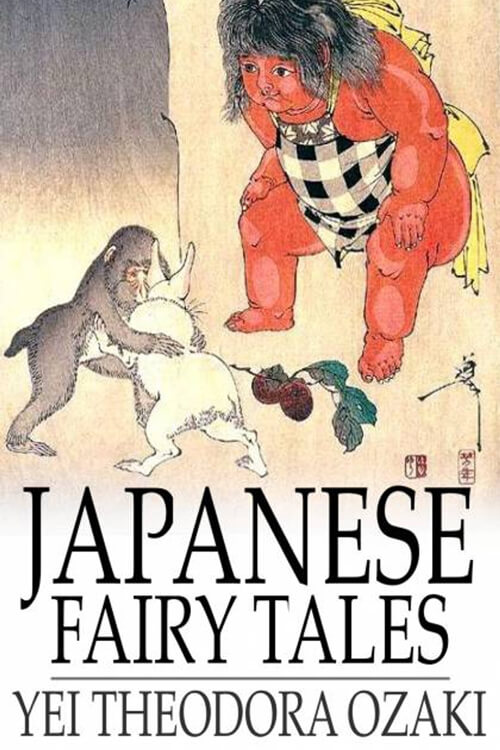
Japanese Fairy Tales
Long, long ago there lived, in Japan a brave warrior known to all as Tawara Toda, or “My Lord Bag of Rice.” His true name was Fujiwara Hidesato, and there is a very interesting story of how he came to change his name.
One day he sallied forth in search of adventures, for he had the nature of a warrior and could not bear to be idle. So he buckled on his two swords, took his huge bow, much taller than himself, in his hand, and slinging his quiver on his back started. He had not gone far when he came to the bridge of Seta-no-Karashi spanning one end of the beautiful Lake Biwa. No sooner had he set foot on the bridge than he saw lying right across his path a huge serpent dragon. Its body was so big that it looked like the trunk of a large pine tree and it took up the whole width of the bridge. One of its huge claws rested on the parapet of one side of the bridge, while its tail lay right against the other. The monster seemed to be asleep, and as it breathed, fire and smoke came out of its nostrils.
At first, Hidesato could not help feeling alarmed at the sight of this horrible reptile lying in his path, for he must either turn back or walk right over its body. He was a brave man, however, and putting aside all fear went forward dauntlessly. Crunch, crunch! he stepped now on the dragon’s body, now between its coils, and without even one glance backward he went on his way.
He had only gone a few steps when he heard someone calling him from behind. On turning back he was much surprised to see that the monster dragon had entirely disappeared and in its place was a strange-looking man, who was bowing most ceremoniously to the ground. His red hair streamed over his shoulders and was surmounted by a crown in the shape of a dragon’s head, and his sea-green dress was patterned with shells. Hidesato knew at once that this was no ordinary mortal and he wondered much at the strange occurrence. Where had the dragon gone in such a short space of time? Or had it transformed itself into this man, and what did the whole thing mean?
Read or download Book
Yei Theodora Ozaki
Yei Evelyn Theodora Kate Ozaki (December 1870 – December 28, 1932) was a Japanese translator of Japanese short stories and fairy tales. Her translations were fairly liberal but have been popular, and were reprinted several times after her death.
Biography
Ozaki was born in London in 1871 to Baron Saburō Ozaki, one of the first Japanese men to study in the West, and an English woman, Bathia Catherine Morrison (1843-1936), daughter of William Mason Morrison (1819-1885) and Mary Anne Morrison. Bathia was one of Ozaki’s tutors in London, and they married in 1869. According to Mary Fraser, in the extract “A Biographical Sketch”, from Warriors of old Japan, and other stories, Bathia lived separately from Ozaki. Bathia gave birth to two further daughters, Masako Maude Mary Harriett Ozaki (b. Jan. 1872) and Kimie Bathia Alexandra Ozaki (1873-1964). Baron Ozaki returned to Japan in 1873 to fulfill an arranged marriage to a Japanese noblewoman, Toda Yae, to continue the upper-class family name of Toda. He eventually moved to a post in Saint Petersburg in an attempt to reconcile with Bathia, who was entered into his family registry (koseki) in 1880, until further issues arose and Bathia returned from Russia in December 1880. They eventually divorced in London, perhaps as Ozaki had fathered multiple children, one with Toda Yae and seven (later totaling 14) with his Japanese mistress Fujiki Michi, creating such a situation as which “her English friends could hardly advise her [to] go.”
After the divorce of their parents in 1881, on the suggestion of a friend of Baron Ozaki, all three daughters grew up with Bathia and their English grandparents in St Alban’s Cottage, Fulham, London. Yei’s grandfather, William, is said to have encouraged her to write in English, which became a mother tongue alongside Japanese. After a spate of missed alimony payments, Yei and Kimie traveled to Tokyo to live with their father in May 1887, with the consent of their mother. Masako stayed in England and married an Englishman in 1906, whilst Kimie later settled in Norway.
Fraser notes that Yei enjoyed the period when she was sent to live with her father in Japan, where she received an education. However, her father expected her to conform to Japanese societal values and expected also her to decide her husband accordingly. However, Yei refused an arranged marriage, left her father’s house, and became an English tutor and secretary to earn money. Eventually, she made the acquaintance of Mary Fraser, wife of the British diplomat Hugh Fraser, and in 1891 Yei became a secretary at the British Legation. After the death of Hugh Fraser in 1894, she accompanied Mrs Fraser on her travels to Europe, particularly to Italy. Yei returned to Japan in 1899, where Fukuzawa Yukichi arranged for a post as a teacher for at Keiō Shinjuku, and she lived in a Buddhist temple.






